Posts Tagged ‘veterinary care in Glen Carbon’
5 Reasons To Microchip Your Dog
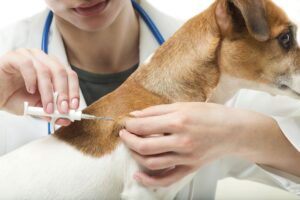 Microchipping your dog could seem useless and unimportant. In reality, it is something that is extremely important for your dog’s life in case anything bad happens. Microchipping involves implanting a rice-sized chip between your pet’s shoulder blades. It is highly recommended by veterinarians, breeders, and animal-rescue organizations. In some countries, it is even law to have your dog microchipped. If the recommendation by your vet is not enough reasoning for you to have your dog microchipped, here are five reasons to stay prepared with a microchip.
Microchipping your dog could seem useless and unimportant. In reality, it is something that is extremely important for your dog’s life in case anything bad happens. Microchipping involves implanting a rice-sized chip between your pet’s shoulder blades. It is highly recommended by veterinarians, breeders, and animal-rescue organizations. In some countries, it is even law to have your dog microchipped. If the recommendation by your vet is not enough reasoning for you to have your dog microchipped, here are five reasons to stay prepared with a microchip.
In case your dog ever gets lost. It may be easy to think that it will never happen to your dog. However, AKC Reunite reports that one in three dogs will go missing at some point in their lifetime. A collar is beneficial in protecting your dog if they get lost, but collars can easily break, fall off, or be removed. A microchip, however, is a reliable and safe way to get the owner’s contact information as well as vital medical information to increase the odds that they will be returned to the owner.
If your dog gets stolen. If a dog is ever stolen, it can be hard to ensure the identity of one dog to another dog, especially if steps have been made to change their appearance. A microchip will clear up any dispute with a quick scan, proving who is the correct owner.
If something happens to you. If you get in an accident and are with your pet, records can be obtained from the pet’s microchip, allowing the authorities to get in contact with your family. Microchips provide identification for not only your pet, but you as well.
Microchips are getting more tech-savvy. Some microchip manufacturers are implementing functionality for smart homes. For example, some chips can communicate with doggie doors to let your dog and your dog only inside or out to prevent unwanted critters from getting in. Other manufacturers also offer lost pet alerting services and even travel assistance for people who like to take their pets along on vacations.
Microchips last a lifetime. Unlike collars, microchips last forever and can’t be lost. Once implanted, you don’t have to worry about them. It can be worthwhile to ask your vet to scan it at a visit to make sure that it is not malfunctioning. It is a simple step that you can take to protect you and your dog.
Microchipping is a fairly inexpensive way to protect you and your family. Especially when you consider the cost of losing your family pet. For this and any other questions or concern for your pet, don’t hesitate to contact us today!
What You Need To Know About Pet Poisons
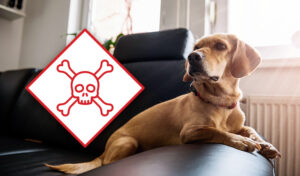 No pet owner wants to hurt their furry friend, but sometimes it is inevitable. Accidental poisonings can be prevented with simple switches in your home. One of the easiest ways to prevent an accidental poisoning is to watch what you plant in and around your house. While plants provide clean air for you home, they can also be really dangerous for pets based on what types of plants they are. Plants that aren’t toxic to humans like the hibiscus, those in the Easter lily family, mistletoe, and Dieffenbachia can cause medical problems in pets. Issues such as renal failure, irregular heartbeats, cardiac shock, or even death. Other examples of toxic plants include azalea, oleander, castor bean, sago palm, rhododendron, and Japanese yew. If you have these plants and cannot stand to give them up, put them up high in an unreachable location where your animal cannot chew or dig them up
No pet owner wants to hurt their furry friend, but sometimes it is inevitable. Accidental poisonings can be prevented with simple switches in your home. One of the easiest ways to prevent an accidental poisoning is to watch what you plant in and around your house. While plants provide clean air for you home, they can also be really dangerous for pets based on what types of plants they are. Plants that aren’t toxic to humans like the hibiscus, those in the Easter lily family, mistletoe, and Dieffenbachia can cause medical problems in pets. Issues such as renal failure, irregular heartbeats, cardiac shock, or even death. Other examples of toxic plants include azalea, oleander, castor bean, sago palm, rhododendron, and Japanese yew. If you have these plants and cannot stand to give them up, put them up high in an unreachable location where your animal cannot chew or dig them up
Your cat may love to snack on some grass outside, but this grass can be loaded up with deadly fertilizers and pesticides. Instead, you could make an indoor mini lawn for your cat. Mini lawns provide a safe, edible source of greenery. Special feline gardens are available commercially or you can start your own kitty garden using a bowl, soil, and grass seed. You could also grow catnip for you cat, but make sure to monitor how much your cat chews. While catnip is not generally toxic for cats, too much of the plant can overstimulate your cat’s central nervous system and cause a cat to injure themselves.
If you find that your pet was chewing on a plant, immediately remove the plant from their mouth and rinse their mouth gently with water. Identify which plant your pet was eating and call the poison center or your veterinarian. Be sure to watch for excessive or foamy salivation and changes in the skin around the mouth, eyes, or paws.
Another common cause of accidental poisonings is giving your pet something intended for a human. This could include people food, chemicals, or even medications. People often make the mistake of thinking that people food is ok for pets. Sometimes it is and sometimes it is not. Be sure to avoid milk, bones, chocolate, onions, rich and fatty foods, grapes, raisins, coffee, nicotine, and alcoholic beverages.
Like a child, one should poison-proof their house. Be sure to keep the cleaning products in a high, closed cabinet. There should be nothing below counter level because liquid drain cleaners, as well as tub and tile cleaners, can be lethal. Be sure to take precautions in the garage as well. Insecticides and auto care liquids need to be store high off of the ground to keep your pets from getting into them. Accidental chemical poisonings can even be made in giving medication. Avoid this by reading the label. For example, be sure to read the labels of flea control for your pets because the chemicals in dog flea agents are lethal for cats. Be sure to read the label directions and amounts carefully.
Some pet owners think that human medication will work for pets. This is incorrect. Never give your pet a human medication without consulting with your veterinarian. Even something as simple as aspirin can be lethal to your pet. Products such as acetaminophen and any aspirin product can cause stomach bleeding. Products like birth control and vitamins can also cause internal bleeding.
Cats tend to be attracted to unusual flavors. Be sure to keep things like the calamine lotion, diaper cream, sunblock, etc. away. These products contain an acid related to aspirin in them and will be toxic if ingested. Overall, small actions you take can help prevent the poisonings of your pets and keep them health. If you have any questions, feel free to contact Dr. Olsen at Olsen Veterinary Clinic at 618-656-5868.
9 Dog Training Tips
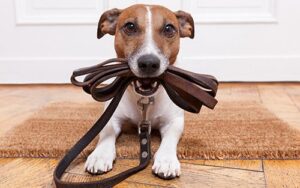 Every puppy needs training, and sometimes it is hard to know what is best for your dog! With these tips, training can be fun and efficient!
Every puppy needs training, and sometimes it is hard to know what is best for your dog! With these tips, training can be fun and efficient!
1. Choose your Dog’s Name!
While this step may not seem to affect training, short names with strong endings are easier for your dog to pick up while training. These include Jasper, Jack, and Ginger. If your dog is an older dog when you begin training, they are probably used to their name. This doesn’t mean that you can’t change it. If your new pal is coming out of an abusive situation, a new name may even represent a fresh start. Dogs are very adaptable to new situations. If you decide to give them a new name, use it consistently and soon enough your pup will respond to it. Whatever you choose to name your dog, be sure to associate it with fun, pleasant experiences as much as possible, rather than negative ones. Ideally, your dog should think of their name in the same was they think of other fun things like walks and dinnertime!
2. Decide on the House Rules
This tip is like number one. Before your pup comes home, decide what is and is not allowed! This can include whether they are allowed on the bed or the furniture. Are parts of the house off limits? Will they have their own chair at the dining table? Setting the rules and expectations early can avoid confusion, for both you and your dog.
3. Help your Dog Relax
When your dog gets home, give them a warm hot-water bottle and put a ticking clock near their sleeping area. This will imitate the heat and heartbeat of litter mates and will soothe your puppy in their new environment. This tip may be even more important for a new dog that previously lived in a busy, loud shelter, particularly if they’ve had a rough time early in life. Whatever you can do to help your new pet get comfortable in their forever home will be good for both of you.
4. Reward Good Behavior
Training is based on rewarding good behavior with positive reinforcement. Use toys, love, praise, and treats of course. Let them know when they are getting it right. Similarly, never reward bad behavior. It will only confuse them.
5. Teach your Dog to Come When Called
The first command you teach your dog should be to come. Get down on their level and tell your pup to come using their name. When they do, get excited and use lots of positive reinforcement. Next time, try the “come” command when they are distracted with food or a toy. As your puppy gets older, you’ll continue to see the benefits of perfecting this command.
6. Train on “Dog Time”
Puppies and dogs live in the moment. Two minutes after they have done something, they’ve forgotten about it. When your pup is doing something bad, use your chosen training technique right away so they have a chance to make the association between the behavior and the correction. Consistent repetition will reinforce what they’ve learned.
7. Discourage Jumping Right Away
Puppies love to jump up in greeting, and some adults have learned bad habits. When your puppy or dog jumps on a person, don’t reprimand them; just turn your back on them, ignore the behavior and wait until they settle down before giving positive reinforcement. Never encourage jumping behavior by patting or praising your dog when they’re in a “jumping up” position.
8. Say No to Biting and Nipping
Instead of scolding your new pet, a great way to discourage your mouthy canine is to pretend you’re in a lot of pain when they bite or nip you – a sharp, loud yell should work. Most dogs are so surprised that they stop immediately. If verbal cues don’t work, try trading your hand or pant leg for a chew toy. This swap can also work when a puppy discovers the joys of chewing on your favorite shoes. They tend to prefer a toy or bone anyway. If all else fails, interrupt the biting behavior and respond by ignoring them.
9. End Training Sessions on a Positive Note
Your pup has worked hard to please you throughout their training. Leave them with lots of praise, a treat, some petting, or five minutes of play. This almost guarantees that they will show up at their next training session with their tail wagging and ready to work!
We hope you find these tips useful. For any other questions about training your new pup, or anything else, please contact us today!
How Do I Know It’s Time To Euthanize My Pet?
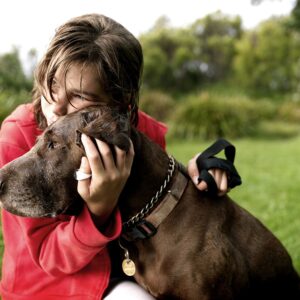 Some pets die of old age in the comfort of their own home, but many others become seriously ill or get injured in a way or experience that significantly diminishes their quality of life as they grow very old. In these situations, owners are often forced to consider the hard choice of whether to have your pet euthanized in order to spare your pet from pain and suffering.
Some pets die of old age in the comfort of their own home, but many others become seriously ill or get injured in a way or experience that significantly diminishes their quality of life as they grow very old. In these situations, owners are often forced to consider the hard choice of whether to have your pet euthanized in order to spare your pet from pain and suffering.
To know when it is time, it is important to talk with your veterinarian. They are the best-qualified person to help guide you through this difficult process. In some cases, your veterinarian may be able to tell you definitively that it is time to euthanize your pet, but in other cases, you may ultimately need to make the decision based on your observances of your pet’s behavior and attitude.
Some signs that your pet is suffering and no longer enjoying a good quality of life include chronic pain being experienced that cannot be controlled with medication, frequent vomiting or diarrhea that is causing dehydration and/or weight loss, they stop eating, incontinence, lost interest in favorite activities, cannot stand on their own, and/or chronic labored breathing. It is a very difficult decision, but one must consider your pet’s quality of life.
Once you have made the very difficult decision, you also need to decide how and where you and your family will say the final goodbye. Before the procedure is scheduled to take place, make sure that all members of your family have had time with the pet to say a private goodbye. If you have children, make sure that you explain the decision to them and prepare them for the loss of the pet in advance. This may be your child’s first experience with death, and it is very important for you to help her or him through the grieving process. Books that address the subject, such as When a Pet Dies by Fred Rogers or Remembering My Pet by Machama Liss-Levinson and Molly Phinney Baskette, may be very beneficial in helping your child to deal with this loss. It is an individual decision whether or not you and your family want to be present during the euthanasia procedure. For some pet owners, the emotion may be too overwhelming, but for many, it is a comfort to be with their pet during the final moments. It may be inappropriate for young children to witness the procedure since they are not yet able to understand death and may also not understand that they need to remain still and quiet.
Deciding when it is time to say goodbye to your pet is never easy. Owners are put into the difficult decision of deciding when it is their time. While it is never easy, the staff at Olsen Veterinary Clinic are always here to answer whatever questions you may have. Feel free to reach out at 618-656-5868 with any questions or concerns you may have!
What You Need To Know About Canine Flu Season
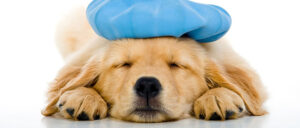
Canine influenza is a highly contagious viral infection that affects dogs and cats. Influenza viruses are able to quickly change and give rise to new strains that can infect different species. Of the two strains identified in the US, both of them can be traced to influenza strains known to infect species other than dogs. At some point, these viruses acquired the ability to infect dogs and be transmitted from dog to dog. Virtually all dogs exposed to canine influenza become infected, with approximately 80% developing clinical signs of disease. The other 20% of infected dogs that do not exhibit clinical signs of the disease can still shed the virus and spread the infection.
Canine influenza is transmitted through droplets or aerosols containing respiratory secretions from coughing, barking, and sneezing. Dogs in close contact with infected dogs in places like kennels, groomers, day care facilities, and shelters are at an increased risk of infection. Canine influenza can be spread indirectly through objects like kennels, food and water bowls, collars, and leashes or people who have been in contact with an infected dog to avoid exposing other dogs to the virus. Due to this, people in contact with an infected dog should wash their hands and clean their clothing to avoid spreading the virus. The virus can stay alive and able to infect on surfaces for up to 48 hours, on clothing for 24 hours, and on hands for 12 hours. It is important to implement cleaning and disinfection procedures to reduce the risk of disease transmission.
The majority of infected dogs exhibit the mild form of canine influenza. The most common clinical sign is a cough that persists for 10-21 days despite treatment with antibiotics and cough suppressants. Affected dogs may have a soft, moist cough, or a dry cough similar to that induced by kennel cough. Nasal and/or ocular discharge, sneezing, lethargy, and anorexia may also be observed. Many dogs developed a purulent nasal discharge and fever. Some dogs are more severely affected and exhibit clinical signs of pneumonia, such as a high-grade fever and increased respiratory rate and effort.
Canine influenza cannot be diagnosed solely by clinical symptoms like coughing, sneezing, and nasal discharge because these signs also present with other canine respiratory illnesses. Tests must be done to properly identify strains of canine influenza virus. Contact Dr. Olsen to set up a test if you think that your dog may be infected.
Treatment for canine influenza is largely supportive. Good nutrition helps dogs mount an effective immune response. Most dogs recover from canine influenza within two to three weeks. Secondary bacterial infections, pneumonia, dehydration, or other health factors may require additional diagnostics and treatments.
While canine influenza is a serious threat, vaccines are available against both strands of canine influenza found in the US. Vaccination can reduce the risk of a dog contracting canine influenza and while it may not all together prevent an infection; it may reduce the severity and duration of illness. As always, feel free to contact Dr. Olsen at 618-656-5868 with any questions or to set up an appointment!
Dr. Olsen’s Breed Spotlight: The Himalayan Cat
 Have you ever seen a cat that looks like a mixture between a Persian cat and a Siamese cat? Well it might have just been a Himalayan cat! The Himalayan cat is a hybrid breed identical to the Persian, but Himalayans are distinguished by the points on the cats’ extremities including the facial mask, feet, ears and tail. This results in a Persian-type cat with the coloring and deep blue eyes of the Siamese-patterned cat. These cats are semi-playful but love to lay around and do nothing. They are typically extremely friendly to other pets and children but require a lot of grooming attention. The breed itself is not very vocal but they have an intense need for attention. All of this is not for nothing as Himalayans are extremely affectionate to their owners.
Have you ever seen a cat that looks like a mixture between a Persian cat and a Siamese cat? Well it might have just been a Himalayan cat! The Himalayan cat is a hybrid breed identical to the Persian, but Himalayans are distinguished by the points on the cats’ extremities including the facial mask, feet, ears and tail. This results in a Persian-type cat with the coloring and deep blue eyes of the Siamese-patterned cat. These cats are semi-playful but love to lay around and do nothing. They are typically extremely friendly to other pets and children but require a lot of grooming attention. The breed itself is not very vocal but they have an intense need for attention. All of this is not for nothing as Himalayans are extremely affectionate to their owners.
Having a firm, well-rounded midsection, they are medium to large in size. Their head is round, broad, and smooth domed. Their jaws are broad and powerful which accompanies a short, snub nose. Their ears are small and round set widely apart on the head. Himalayan’s coats are long all of the body with a dense undercoat. Perhaps the most striking attribute of the Himalayans are their large, round, and deep blue eyes. It gives their face a sweet expression.
Himalayans are wonderful indoor cat companions. They are gentle, calm, and sweet-tempered. Like Siamese cats, Himalayans love to play fetch with a piece of crumbled paper or a cat toy. They will be entertained for hours, or at least until their next nap. Himalayans are devoted and dependent upon their humans for companionship and protection. They crave attention and affection. Like their Persian siblings, they are docile and won’t harass you for attention the way that some breeds will. They possess the same activity level as the Persian but lack the vocality of a Siamese.
The Himalayan cat is an extremely beautiful cat that makes for a good family pet. While they are striking, it is important to make sure before adopting that you are able to give them the care that they need due to their intense grooming requirements. If you think you are able to give them the attention that they need (and want), then you just may be the right person to adopt a Himalayan cat that needs a home. If you have any questions, please feel free to contact Dr. Olsen at 618-656-5868.
Tips For Traveling With Your Pet This Summer
 Traveling is an exciting yet stressful time for humans. Bringing your pet along usually adds to the stress level because it brings along extra preparation and attention to detail. Driving and flying each have their own challenges, but with the right advice, traveling with your pet can be a breeze. No matter where you are going or how you get there, it is important to have your pet wearing a collar and tag with your name, phone number, and any other contact information including emergency numbers.
Traveling is an exciting yet stressful time for humans. Bringing your pet along usually adds to the stress level because it brings along extra preparation and attention to detail. Driving and flying each have their own challenges, but with the right advice, traveling with your pet can be a breeze. No matter where you are going or how you get there, it is important to have your pet wearing a collar and tag with your name, phone number, and any other contact information including emergency numbers.
Unless your pet is small enough to ride with you in the cabin of a plane, air travel is extremely stressful but sometimes unavoidable. When flying by plane, it is best to book a direct flight whenever possible. This will decrease the chances that your pet is left on the tarmac during extreme weather conditions or mishandled by baggage personnel during a layover. Also, make sure that your pet’s vaccinations are up-to-date and that their overall health is good dated within ten days of your departure. At your appointment, you can also discuss sedation methods if you suspect that they may become anxious. One of the most important aspects of airline travel with your pet is the crate. The crate should be large enough for your pet to stand, sit, and turn around in comfortably. It should be USDA-approved and lined with shredded newspaper or towels to absorb accidents. Prior to your trip, tape a pouch of food to the outside of the crate so airline personnel will be able to feed your pet in case they get hungry while traveling. The night before you leave, freeze a small dish of water that will be melted by the time they may be thirsty. Make sure that the crate door is securely closed, but not locked, so that airline personal can open it in case of an emergency. Make sure that the crate is marked “Live Animal” as well as your name, cell phone number, emergency phone number, and a photo of your pet. In case your pet escapes, the photo can be a lifesaving measure.
When driving, traveling with pets involve a lot more than just loading the animal in the back seat. It is important to get your pets used to a long trip by taking them on short trips and slowly lengthening the time spent in the car. Keep your pets in a well-ventilated crate or carrier. The crate should be large enough for your pet to stand, sit, lie down and turn around in. Be sure to secure your pet’s crate so that it does not slide in the event of a sudden stop. If you don’t use a crate, be sure to keep your pet in a harness attached to a seat buckle. Be sure to bring a pet-friendly travel kit with food, bowls, leashes, poop bags, medication, and any travel documents. Be sure to bring a favorite toy or pillow to give your pet a sense of familiarity. Be sure to pack plenty of water and avoid feeding your pet in a moving vehicle. Your pet’s travel feeding schedule should start with a light meal three to four hours before departure. Perhaps most importantly, you should never leave your animal alone in a parked vehicle. In hot weather, the car turns into a furnace causing a risk of heatstroke. In cold weather, the car turns into a refrigerator holding in the cold which could lead to freezing to death.
However, you choose to travel with your pet, it is important to do it safely. By following these tips, both your stress and your pets’ stress can be reduced greatly making travel day a lot easier for both of you. If you have more questions about this or anything else regarding your pet, contact our office today!
Breed Spotlight: The Otterhound
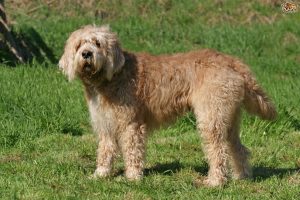 Otterhounds are an extremely uncommon dog breed, especially in the United States. Weighing between 80-115 pounds, otterhounds are big, boisterous, and affectionate. Bred in medieval England, their breed was originally intended for the now-outlawed activity of otter hunting. Medieval England had a huge otter population which preyed on fish in rivers and ponds. To protect the valuable food source, packs of Otterhounds were kept by country squires and even kings. Otterhound packs were too good at otter hunting. River otters nearly went extinct and hunting them became outlawed. Otterhounds are extremely unique as they have a dense shaggy coat, webbed feet, an acute sense of smell, and an affinity for swimming.
Otterhounds are an extremely uncommon dog breed, especially in the United States. Weighing between 80-115 pounds, otterhounds are big, boisterous, and affectionate. Bred in medieval England, their breed was originally intended for the now-outlawed activity of otter hunting. Medieval England had a huge otter population which preyed on fish in rivers and ponds. To protect the valuable food source, packs of Otterhounds were kept by country squires and even kings. Otterhound packs were too good at otter hunting. River otters nearly went extinct and hunting them became outlawed. Otterhounds are extremely unique as they have a dense shaggy coat, webbed feet, an acute sense of smell, and an affinity for swimming.
Tips For Dealing With Your Long-Haired Dog This Summer
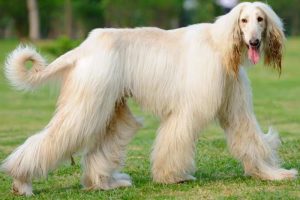 When it comes to dogs, it’s no surprise that long-haired dogs are extremely gorgeous. Unfortunately with all of the beauty and fluff that they possess, long-haired dogs come with a bit more work when it comes to grooming them. In order to groom long-haired dogs, regular bathing is a necessity. On average, you should be bathing and grooming your dog once a month with two months being the absolute longest you go in between washes. Some dogs can be groomed every other week so long as you are using a dog shampoo that is gentle. Be wary of over bathing your dog as washing too frequently can result in dry skin.
When it comes to dogs, it’s no surprise that long-haired dogs are extremely gorgeous. Unfortunately with all of the beauty and fluff that they possess, long-haired dogs come with a bit more work when it comes to grooming them. In order to groom long-haired dogs, regular bathing is a necessity. On average, you should be bathing and grooming your dog once a month with two months being the absolute longest you go in between washes. Some dogs can be groomed every other week so long as you are using a dog shampoo that is gentle. Be wary of over bathing your dog as washing too frequently can result in dry skin.
When bathing a long-haired dog, matts are a very real issue and requires plenty of patience when bathing. Be sure to use lots of pet shampoo and work from the head down. Starting at the head and then working down from the back will allow you to lather the entire coat evenly and prevent you from having to go back to any missed areas. After you scrub the back and torso, move on to spot clean areas like the belly, chest, legs, and tails. Rinse from head to toe, and then let your dog shake off all of the excess water. Especially with long-haired breeds, it is important to let your dog shake dry as it makes the drying process a lot more manageable. Air drying is the best method for your dog’s skin even though it takes the longest and it might leave your dog with a bit of a “wet dog” smell. Blow drying might lead to skin irritation. Towel drying is the happy medium wherein you can dry your dog 90% of the way and let them air dry the last 10%. Even if you air dry, remember to wipe the ears and paws at these sensitive areas to avoid bacteria grown.
After bathing, brushing should be done immediately to remove any excess dog hair that has come off during the bath. While brushing should be a daily part of your dog’s grooming routine with a long-haired dog, it is especially important in the first few days after a bath. Bathing stimulates the skin and promotes new hair growth. As a result, your dog will shed the most right after a rinse. It is crucial to help the regenerative process of hair growth by eradicating all of the hair your dog is trying to rid itself of.
Some may choose to clip their dogs coat after cleaning. If you are trying to go for a certain cut, decide on the shape you are trying to achieve and then clip small amounts at a time to ensure you don’t take too much away. Clipping is one of the most challenging and potentially scary parts of grooming a long-haired dog. Because of this, there is no shame in reaching out for professional assistance. At Olsen Veterinary Clinic, we have an in-house groomer! Contact Karen with Prancing Paws Grooming at 618-910-7581 with any questions or to schedule a grooming appointment!
One of the most integral parts of grooming is cleaning your dog’s ears. Dog’s ears are one of the most sensitive areas but also one of the most susceptible areas to nasty things like yeast infections or mites. After bathing, take time to clean the inside of your dog’s ears with cotton or a similar material that has been lightly covered in witch hazel. Be vigorous in cleaning your dog’s ears without being rough or obtrusive. It is essential to clean all of the flaps and folds inside the ear but be careful to avoid entering the ear canal.
As always, if you have any questions or concerns, feel free to contact Olsen Veterinary Clinic at 618-656-5868.
Food Allergies In Pets: What You Need To Know
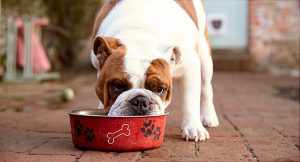 With the onset of spring, many pets are exposed to the outside environment. This has caused them to become more “itchy” and their scratching has caused discomfort to then leaving the owner searching for possible remedies. Unfortunately, their scratching and head shaking may be caused by the diet that they are fed.
With the onset of spring, many pets are exposed to the outside environment. This has caused them to become more “itchy” and their scratching has caused discomfort to then leaving the owner searching for possible remedies. Unfortunately, their scratching and head shaking may be caused by the diet that they are fed.
Many dogs and cats for that matter may suffer from food allergies. These allergies can hit about anytime during their lives and present itself with many different symptoms. These symptoms may range from odorous, greasy, dander-laced hair with chronic ear issues to maybe diarrhea with increased flatulance. Your pet may be constantly chewing on its paws, making them red and keeping you up at night with its chewing and licking. A lot of time, we will try and just mask the signs so that they can remain comfortable without diagnosing the problem. Chances are they inherited the trait from their parents.
When these signs appear, looking for the food that causes the issues may be real difficult in finding and the testing is even more difficult. Common food allergies may consist of beef, pork, chicken, corn, wheat, or a number of other ingredients. Food allergies may include one to many ingredients in the diets, so it is not as cut and dried as it may seem to just switch diets. Also blood testing is of no use in determining the allergies.
So with that said, food ingredient avoidance is the best means of controlling the allergies. So an owner may be instructed to feed a very limited ingredient diet for several weeks and see how the pet responds to the diet. Will the pet be pruritic? Will the pet’s skin be odorous? If the clinical signs are better, then you may be able to add additional ingredients and see how your pet responds.
Some owner’s will prefer to feed raw diets or homemade diets. However, those will sometimes be difficult to balance the ration to get the proper minerals and vitamins. Regardless of what you choose, do not hesitate to contact our office and we can help you navigate this issue. Contact us today.
